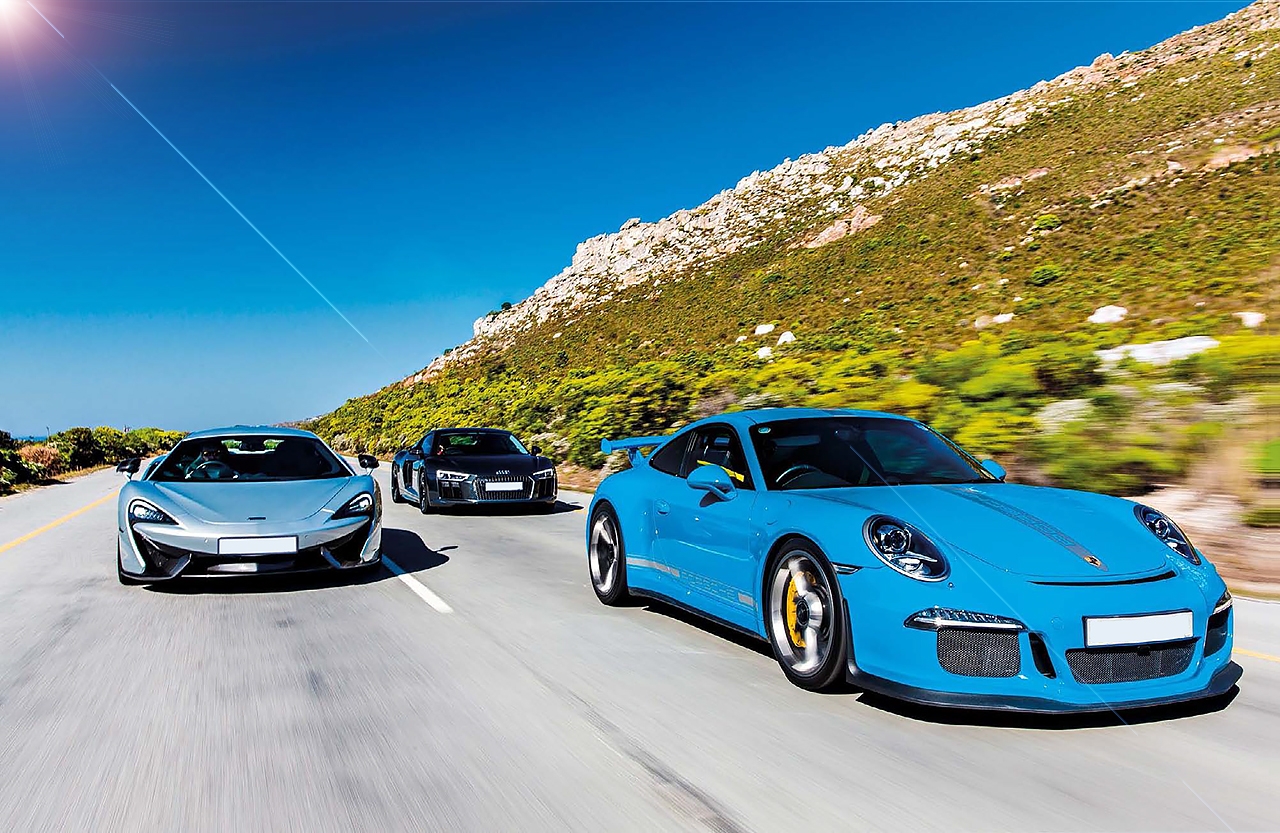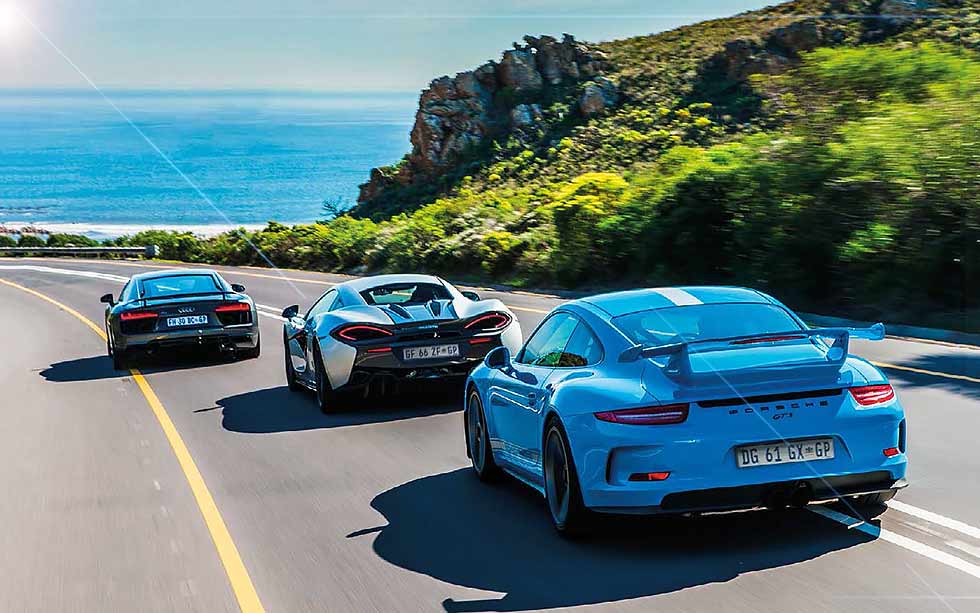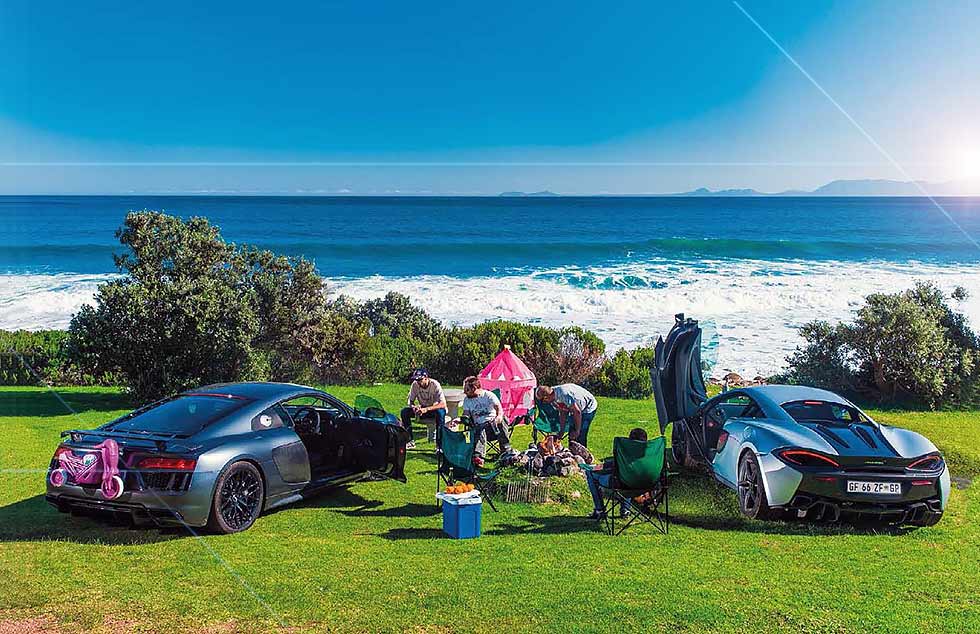
Heritage Day. It’s why makarapas exist, Kwaito bests foreign beats, some of us wear two-tone khaki outfits and we all love pap. Words: Lance Branquinho. Photography: Jaco Le Roux.
Having inherited tradition, we are given a burden of responsibility: its custodianship in the present. Alter and reinterpret it a bit, sure; but respect it, and then gift it to those who follow.
As in life, so also in octane-powered performance vehicles with wheels but no second-row seats. Automotive heritage is the reason Porsche 911 Rs trade for R8m, when they cost less than a third of that new. You can’t counterfeit heritage. There’s no app for it in the PlayStore. A lineage of remarkable cars and noteworthy happenings either detail your brand or product history, or they don’t. It transcends the balance sheet. And it takes time. Reference example: Kia and Hyundai. Perhaps… even Audi.

Audi. R8. The German Gallardo, a mid-engined supercar from Merkel’s economic miracle when there were none available from BMW, Mercedes-Benz or Porsche. Boldly designed, impeccably built and purposefully named to profit from Audi’s rampant Le Mans domination over the last decade, the R8 was even good enough for Iron Man. A Hollywood product-placement request is perhaps the ultimate validation of supercar status, which – much like an SAA Voyager Platinum card – is not easily earned. The original R8 was a symbol: that Audi’s time had come.
Regrettably, time is a cruelly duplicitous entity: a decade in the automotive product cycle is similar to suffering through agonisingly slow, 30-second Snapchat image renderings. Attention will be diverted to other things. And the original R8 was around for far too long – nearly a decade.
Paradoxically, a decade’s also far too short to establish heritage. Tricky. That’s why the new R8’s not been all that kindly received: it looks too familiar, with an engine that’s the same too.
So to discover whether it’s worthy of championing Audi’s cause – to establish itself as a genuine supercar brand – we’re going to head out and do a very South African thing: braai. Why? Because September is heritage month, with braai day on the calendar; and our South African automotive heritage is unrivalled on the continent of which we got the little bit at the very bottom.
The journey to this heritage braai is our uniquely native supercar test, and it’s one that could only be quested in Mzansi; the roads and the cars to measure the R8’s worth simply aren’t all available in Africa’s biggest economy (that’s Nigeria, allegedly), or in any of the other 53 states. It’s our proudly RS-of-A heritage: we’re the African car people.
McLaren. Sounds Scottish, but its heritage is inarguably more Southern Alps than Highlands. Although the road cars, especially our 570S test unit, have only been around for six years since the post-F1-three-seater revival, the brand’s heritage is indisputable. It could be due to the F1 heroics of Senna and Häkkinen, but McLaren founder Bruce was a revered automotive innovator. A petrolhead of great courage, crippled by polio, he migrated from his native New Zealand to become a force in European racing. He died tragically young, at 32, in a 1970 testing accident at Goodwood.

When your founder passes into legend, that’s a heritage that’s difficult to undo. It might be the most affordable (relative term, that) and least powerful of McLaren’s current offerings, but its suite of technology is astounding. McLaren’s F1 team (also known, colloquially, as ‘Jenson Button’s retirement employer’) may have become a little bit rubbish, since the road-car division restarted – hazard a guess where all the best engineers went? – but that’s done little to discredit the calibre of machinery on offer. WhattsApp call requests. Screen-distracted Pokémon Go geeks walking into you at the park. Sexting autocorrect fails. Not one of these everyday struggles is testing in quite the same manner as an Audi spokesperson speaking about… aluminium. You’d think aluminium was the key to Middle East peace and brings families together as a metal token of reconciliation, the way Audi evangelises about it. Problem is, despite all its clever aluminium bits, the R8 is about 200kg heavier than the bigger but carbon-fibre-chassis-ed McLaren. #Awkward.
The failed F1-team road car is but half the jury for our heritage outing’s measure of what the R8’s worth. Enter Porsche: the original prancing-horse-badge performance-car brand, and with a heritage more valuable than any other. All this despite nearly going bankrupt in the early 1990s.
It remains the seminal sports-car company, Porsche. With its quarrelling Piech and Porsche family members, Le Mans heroics, and incorrectly engineered, rear-engined 911s, it should have failed decades ago. Instead, Porsche’s coolness factor in 2016, especially with the 911 family, is nearly inestimable. Hence the presence of a 911 GT3 – one of the very purest of all the 911s – in our supercar convoy.
Our three heritage-month, braai-questing supercars are – comparatively – greatly different in configuration. Audi R8: mid-engined, naturally-aspirated V10, all-wheel drive. McLaren 570S: mid-engined, turbocharged V8, rear-wheel drive. Porsche 911 GT3: rear-engined, non-boosted flat-six, rear-wheel drive. The R8 has a desperately clever locking centre differential, the Porsche a slip-countering one at the rear; and McLaren?
There’s just an open differential between you and 600Nm making peripheral scenery into primary. The only similarities in configuration for all three is the number of pedals, and the number of gears: two and seven of each, all with dual/twin clutches managing the shifts between. It’s a warning, of how taxingly fast these cars have become to drive at the true tipping point of their potential, that manual transmission is now undesirable in any. Even the GT3.
If you long for that forbidding test of skill (and survival) that is shifting across a gate, and clutching, Porsche’s most revered nameplate you’ll have to embrace the fabric-seated scarcity of the 911 R’s six-speed ’box . To trace one of those, you’ll also need to be either the mayor of Stuttgart, or have family who work at Porsche’s VIP customer-care centre.
Without the possibility of stalling, these are very much post-millennial supercars: terrifyingly fast, but subservient enough not to humiliate you when parallel parking in front of that posh Parktown eatery. We’re not at Jozi altitude, though. Being democrats with two naturally-aspirated cars in our procession of provenance, our journey is as near as possible to sea level – where the happy coincidence of South Africa’s best driving roads also happens to be.
In 2016, Bafana’s been awful. The Springboks, too. And we can’t even order trains of the correct size to rail our tracks. Our government believes that the more rands we pay for dollars and euros, the better; and tragically, getting Khanyi Mbau to ‘normal’ is not among the #ThingsMmusiDid. But we have these cars, and roads that reduce European driving royalty to tears. Life’s all right, then.
Despite the familiarity of its iconic shape, any 911 – and particularly the GT3 – grows more pleasing in aesthetic the better the road it’s on, and the setting it’s in becomes more majestic. With those centre-lock wheels and that authentically aero (rather than vainly aftermarket) rear wing, it’s unapologetically a tamed racing car in appearance. And that stance! Crisis. From any angle aft of its rear axle line, you need to cover the eyes of children trying to sneak a peek, because it triggers mechanophilia like no other.
The GT3’s twinned exhausts, with their huge, mole-swallowing diameter, are true to purpose too; none of those faux-rectangular- and parallelogram- shaped fake ends designers have forced upon us in other cars.
Like the R8. If this new Audi was a wedding, the bride would commit suicide: its detailing is terrible. Artificial, in the manner of wearing a veil when you’ve been living in sin together for months before the ceremony.
How so? Plastic gridding is how. It’s everywhere. We understand that not all the exposed engine metal and its exhaust plumbing bits, which get rather hot, can be touchable; but why extend these plastic grids to the aero intake ducts in the R8’s switchblades? Especially when they’re not even grids, but solid mouldings with some bogus grid detailing. Dreadful.
McLaren would never allow such a deceiving air-management styling feature on its 570S. With plentiful exterior surface ducts and more carefully-shaped edges than a Lockheed F-22 Raptor, it is inarguably the most advanced-looking of the three cars. Also the quickest.
Argue secret, rubberised, manufacturer test-track numbers all you want, but McLaren’s 570S is ultimately fastest – and certainly feels it. Statistically, it draws with the R8, both running the nonsensical 100kph benchmark in 3.2 sec (GT3’s three tenths slower); but beyond that speed, with those turbochargers boosting, it becomes an almost unsettlingly faster car to be in. You could credit the advantage of those 40 more torques the 570S has over the R8 (the Porsche trails by 160Nm), but more telling is that R8 is 211kg heavier (and the GT3 86kg heftier), gifting undeniable real-world speed superiority to the 570S.
It sounds awful, though. The McLaren. Unnecessarily and disappointingly so. It’s a flatplane crank V8, related in structure to the P1, with different valvegear and internals from its middle-sibling 650S; but it somehow manages to combust fuel into noise in a register that’s a lot more GT than GT3. It’s also the first McLaren with stop-start, so perhaps the acoustics suffer because of some innate Captain Planet principle. With Porsche, the hills are always alive with the sound of, well, unleaded reverberating.
They’re Austrian in heritage, the Porsche family – not German (hence our painful Sound of Music pun in the preceding sentence). The GT3’s engine might be in the wrong place, but it does everything else so very right: redline at 9000rpm, a frustrated racer’s roll-cage instead of rear seats, and composite brakes – the power of which can do more damage to a typical South African road surface than an overloaded 18-wheeler ever could.
Howling along this perfect coastal road, so generously paid for by South Africa’s three-and-bit million taxpayers, the GT3’s mechanical majesty overwhelms, despite having the least power (350kW) and torque (440Nm). It just keeps going. And going. Eventually disappearing out of our two-way radio receiver’s range with a cabin drowned in noise, mechanically silencing even the most alarming Smartphone ringtone; its driver, answering a higher petrolhead calling. The GT3, for all intents and ultimate purposes, is gone.
One car down. Two left. Easier braai-side parking for the Audi and McLaren, then. Such natural rivals (notwithstanding their different lineages), these two: McLaren obsessed with F1, Audi’s competition preoccupation being Le Mans. We’re biased towards the world’s greatest race, a technology showcase peppered with human drama and genuine respect between competitors. Unlike F1.
Audi cabins have a significant reputation for comfort and ergonomic intuition. R8’s is the least intimidating of any mid-engined car you’ll ever slide a hip into. For a company that builds R18 racing cars, required to operate at maximum for 24 straight hours without fatiguing their pilots, the thread of logic is self-evident.
Similar to its exterior, 570S’s cockpit is reminiscent of a fighter aircraft: digital menu screens everywhere – all of which are a touch too complicated and (ironically) counter-intuitive to use.
Negligence at the 570S’s helm has real consequence; and perhaps the absence of active aero, and presence of anti-roll bars at all four wheel corners, instead of the 650S’s complex decoupling dampers, is the discrepancy. It’s a ridiculously rapid car that’s been artificially engineered to feel ‘engaging’ – perhaps too ‘engaging’ for the uninitiated.
In mitigation, 570S is mid-engined and RWD, a configuration privilege few automotive engineers are willing to allow owners the full experience of these days, given the responsibility of managing 400kW-plus through only two, instead of four, contact patches. Having arrived safely at our seaside braai destination, it’s time for reflection. Mostly on the question of the new R8, and whether this second generation, uncomfortably, is just a version 1.5. Some of its styling details are indisputable in their awfulness; and at 1753 metres, in Jozi (where we’re not, at this moment), the McLaren’s turbocharged performance will lunch it everywhere.
The truest heritage of a mid-engined supercar has always been its engine. The anchor, (meta)physically, of its being. And this R8, almost accidentally, has a great one. It should have been future-proofed with turbocharging, but our gratitude for it not being is immense. Everything else is forgivable detail.
R8’s steering isn’t perfect (the algorithm’s too quick, sacrificing counterweight), and the 570S’s ability to cover metres per second around curves is greater – but not necessarily better. You fall in love with that 5.2-litre Huracán-twin V10’s sound, and linearly predictable power delivery enabling untroubled mid-corner corrections. It’s a terribly easy car to drive very quickly, but never unrewardingly so.
No matter how averagely skilled you are or how overly ambitious you’re being, R8’s balance and Quattro traction security absorb and reward, without intimidating or humiliating. Adding boost would undo all of this. Audi deserves its right of heritage with this R8 2.0. By retaining an atmospheric V10, with all the uniqueness of pitch and performance that entails, it’s done the unthinkable. Brilliantly. As our cheap braaiwood smokes away pathetically, the scene is rather worth taking in: two mid-engined supercars, towering mountains, and a perfect road cut into them, bordering an ocean clearer even than even the LEDs of this newest R8… South Africa. It’s our heritage: we’re the car people at the tip of the second-biggest continent. May it always be so. Marakapas in Audi’s Le Mans pit area next year? We’re working on it.
Fake intake is design illiteracy, or stupidity, simply beyond belief “Laser lights” sounds cool, but they sadly won’t slice the slow car ahead in half to let you through.
570’s packaging superior. R8’s luggage bay bested by a children’s toy. Ceramic stoppers standard on this Plus. Audi’s learnt from Porsche.
Phenomenal composite brakes. Typically Porsche, your internal organs will fail before they fade.
GT3 3.8 is The One. RS 4.0 false economy, stroked by 4mm, slowing the flat-six’s frantic crankspeed pace.
Driving a GT3 is thirsty work. (Alcohol-free) drink stowage slightly rubbish compared to the cup-holders offered in 570 and R8.
Phenomenal composite brakes. Typically Porsche, your internal organs will fail before they fade.
In GT3 spec, Porsche’s most iconic car has a stance the envy of all. Form following function, perfectly.
Triggers statistical OCD, being one unit short of 450kW, but also the most inspiring Audi engine on sale. Ever.
“DESPITE ALL ITS CLEVER ALUMINIUM BITS, THE R8 IS ABOUT 200KG HEAVIER”
F1 heritage evident. Mac has weave everywhere. Carbon-fibre fetishists rejoice Honda had absolutely nothing to do with this turbocharged V8. Unlike the F1 car. Better that way.
McLaren’s starter pack offering has performance way beyond that of most other brands’ very best halo cars.
PORSCHE 911 GT3 991
Price: R2.3m (sold out)
Engine: 3799cc flat-six, 350kW @ 8250rpm, 440Nm @ 6250rpm
Performance: 0-62MPH (0–100kph) in 3.5sec, 315kph
Transmission: 7spd PDK dual-clutch, RWD
Economy: 11.7l/100km, 289g/km CO2
Weight: 1430kg
AUDI R8 PLUS
Price: R2 970 000
Engine: 5204cc V10, 449kW @ 8250rpm, 560Nm @ 6500rpm
Performance: 0-62MPH (0–100kph) in 3.2sec, 330kph
Transmission: 7spd DSG dual-clutch, AWD
Economy: 12.3l/100km, 287g/km CO2
Weight: 1555kg
MCLAREN 570S
Price: R3.7m
Engine: 3799cc twin-turbo V8, 419kW @ 7500rpm, 600Nm @ 5000rpm
Performance: 0-62 MPH (0–100kph) in 3.2sec, 328kph
Transmission: 7spd SSG dual-clutch, RWD
Economy: 10.7l/100km, 249g/km CO2
Weight: 1344kg
{CONTENTPOLL [“id”: 74]}





